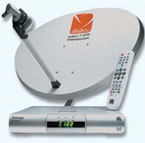The prime time dilemma

Home entertainment has come a long way from the days of Doordarshan to the age of satellite television (Cable TV) and now DTH (Direct-to-Home) and Internet Protocol TV (IPTV). With so many technologies vying for your home entertainment space, it’s a tough choice to make especially as each television platform offers different benefits and viewing experience.
For many such as Mrs Chaudhari from Worli (south Mumbai) the choice was not easy. Says Mrs Chaudhari: “When CAS was introduced, we had to make a choice whether we want to continue with Cable TV or to go for DTH. As a society we opted for DTH as we got a good deal.”
But now the home entertainment canvas has expanded as MTNL and BSNL have introduced the IPTV platform through telephone connections. IPTV is delivered using IP technology that delivers signals to your television and other video content transmitted over a broadband network.

Pay as You Watch
But let’s evaluate the costs. For the conditional access television, the price structure is fixed by the Telecom Regulatory Authority of India. Essentially, there are two schemes on offer—one gives a settop box for a refundable deposit of Rs 999 and a monthly rental of Rs 30, and the other has a monthly rental of Rs 45 with a refundable deposit of Rs 250 on the set-top box.
If one does not want a set-top box (STB), cable operators offer 30 freeto-air channels for Rs 77 a month. With a set-top box you pay an additional Rs 5 per pay channel. For a consumer, say, who chooses 15 pay channels, his monthly bill would work out to Rs 182, which includes the basic Rs 77 along with Rs 75 for 15 pay channels as well as monthly rent of Rs 30.
Similarly, MTNL’s IPTV is available for an introductory rate and a onetime activation and installation fee of Rs 999. For now, the monthly subscription is Rs 199 for 150 channels with the set-top box rental Rs 100 per month. Currently, there is no separate pricing for channels, which could change later.

Both Cable and IPTV pricing are currently lower than what the DTH operators charge. Tata Sky sells the DTH set-top box for Rs 2,999 and charges Rs 1,000 for installation. It offers channel packages that range from Rs 200 to Rs 350 per month with a choice of 80 to 140 channels. Zee-owned Dish TV offers a set-top box at Rs 2,950 and with an installation fee of Rs 200. Packages range from Rs 100 per month to Rs 300 per month and consumers can choose from 85 to 170 channels.
Hi-tech in Entertainment
DTH operators claim that they are in touch with customers directly and the installation is done by company engineers, unlike in cable service where the middleman— the local cablewallah—does the last mile connectivity. Another benefit: DTH is geographically mobile. If a DTH subscriber is moving home, he has to only pack up his dish, set-top box and reinstall it at his new place. DTH satellites have a national footprint and can reach anywhere in the country. With a cable box, even a minor shift within a city entails you to switch cable operators. Also, if you miss your favourite and popular show like an ‘Indian Idol’ you could still catch up with it the next day on DTH platforms.
On the other hand, one multisystem operator (MSO) in Mumbai, on condition of anonymity, points out that while CAS offers rental and deposit schemes on their set-top boxes, DTH operators do not offer this facility—a consumer has to make a one-time full payment to get DTH services.

As for IPTV, the newest entertainment platform on the block, A.S. Oberoi, Executive Director, IOL Broadband, says: “IPTV is a very good alternative to CAS and DTH. The two crucial differentiating factors of IPTV services are ‘on-demand services’ as well as the interactivity capability.
This enables a subscriber to have total control over the media because of two-way connectivity.” As of now, MTNL is the only one offering IPTV in Mumbai, but more telecom companies are expected to offer this facility in the coming months. Technology experts opine that while IPTV is a great medium, it still has a long way to go in India as broadband connections in India have still not reached a critical mass and speeds are not up to the mark.
While some like Mrs Chaudhari have made their choices, it’s best for you to stick to a competitive pricing package and with the technology you are most comfortable with.










